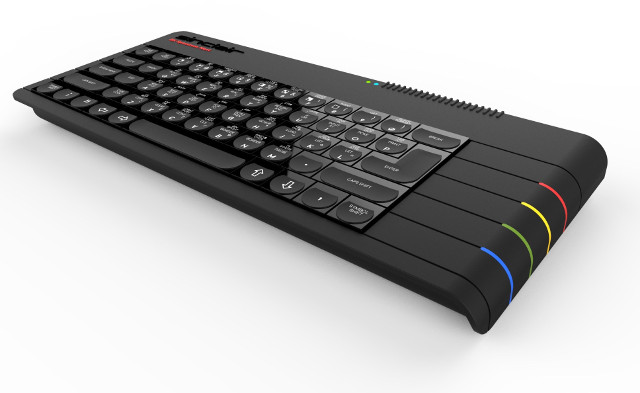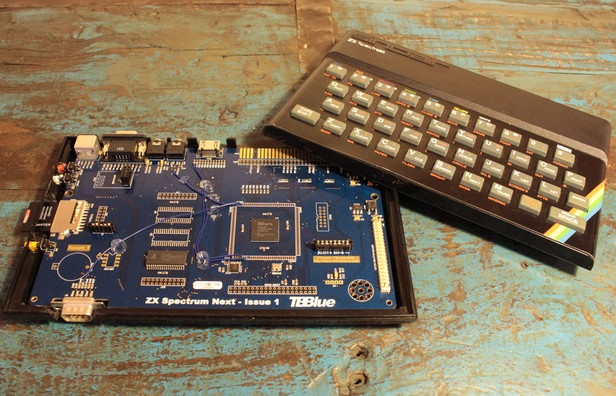ZX Spectrum keyboard computer was launched in April 1982 in the United Kingdom, and 35 years later, a team of developers has now been working on ZX Spectrum Next somewhat resuscitating ZX Spectrum by emulating Z80 processor in a Xilinx FPGA, using an optional Raspberry Pi Zero board as an accelerator, and adding some modern features like HDMI output and WiFi.
 While the case is only a 3D rendering for now, they have a working board prototype with the following specifications:
While the case is only a 3D rendering for now, they have a working board prototype with the following specifications:
- FPGA – Xilinx Spartan-6 FGPA emulating Z80 processor in 3.5Mhz and 7Mhz modes
- System Memory – 512KB RAM (expandable to 1.5MB internally and 2.5MB externally)
- Storage – SD Card slot, with DivMMC compatible protocol used in the original ZX Spectrum
- Video
- Hardware sprites, 256 colours mode, Timex 8×1 mode etc.
- Output: RGB, VGA, HDMI
- Audio – 3x AY-3-8912 audio chips with stereo output + FM sound
- Networking – Optional WiFi module
- Joystick – DB9 compatible with Cursor, Kempston and Interface 2 protocols (selectable)
- PS/2 port – Mouse with Kempston mode emulation and an external keyboard
- Special – Multiface functionality for memory access, savegames, cheats etc.
- Tape support – Mic and Ear ports for tape loading and saving
- Expansion – Original external bus expansion port and accelerator expansion port for Raspberry Pi Zero
- Misc – Real Time Clock (optional), internal speaker (optional)
- Power Supply – 9V
Spectrum Next board can also fit into the original case, if you find the new design too… well new.
 The Raspberry Pi Zero is used to bring OpenGL support to the ZX Spectrum, as well as more memory and a faster processor, so beside running retro apps on the ZX Spectrum Next, you can also run apps that would not work before. The good news is that the board already works, and you can run program in normal or accelerated mode, Doom, Wolfenstein 3D and more. The source code for the FPGA’s Z80 core will be released to the community.
The Raspberry Pi Zero is used to bring OpenGL support to the ZX Spectrum, as well as more memory and a faster processor, so beside running retro apps on the ZX Spectrum Next, you can also run apps that would not work before. The good news is that the board already works, and you can run program in normal or accelerated mode, Doom, Wolfenstein 3D and more. The source code for the FPGA’s Z80 core will be released to the community.
ZX Spectrum Next has launched on Kickstarter, and has been rather popular so far having raised over £412,111 out of its £250,000 goal. If you want to upgrade your old enclosure, you could pledge £99 ($128 US) for the board only, but if you want the full package with the new enclosure, you’ll have to pledge at least £175 ($226). It’s probably not coincidence that’s the same price as the original ZX Spectrum with 48KB RAM when it launched in April 1982. Delivery for the board only is schedule for August 2017, while you’re expected to wait until January 2018 for the full version. Shipping adds 10 quids to the United Kingdom, and 25 quids to the rest of the world.
The Register reports there is no relationship between RCL, the company behind the failed ZX Spectrum-branded Vega and Vega+ consoles, and the team working on ZX Spectrum Next.
Via Liliputing

Jean-Luc started CNX Software in 2010 as a part-time endeavor, before quitting his job as a software engineering manager, and starting to write daily news, and reviews full time later in 2011.
Support CNX Software! Donate via cryptocurrencies, become a Patron on Patreon, or purchase goods on Amazon or Aliexpress






For £3.68, UK.farnell.com will sell you a ZILOG Z84C0010PEG CPU, Z80 Series, NMOS / CMOS, 10 MHz, 5 V, DIP-40
After that the rest of the computer is your Problem 🙂
The ZX Spectrum was the first computer I owned. There was one thing I really didn’t like, and that was the keyboard. So you must be a hard-core Spectrum lover if you want to recreate that keyboard … 😉
A spanish forum of ZX spectrum lovers built an emulator based on a FPGA. Their project seems quite interesting:
http://zxuno.speccy.org/index_e.shtml
Isn’t it 100x times easier to emulate the Z80 in the pi in software?
Their are several ZX Spectrum emulators in Google Play store.
@dxin
No, clock-perfect emulators (like this one) are notoriously-hard to get right, and require multiple-orders of magnitude faster hw to work reliably. Here you can read further on the subject: http://www.tested.com/tech/gaming/2712-why-perfect-hardware-snes-emulation-requires-a-3ghz-cpu/
I get the desire for a hardware Spectrum, some nostalgia buffs like to have physical object that they can hold. But why a Raspberry Pi for “OpenGL”? No legacy software uses it, not much new software will be written for this, so where’s the use case? Personally I’m with dxin, I’d put an RPi in the case and wire out the necessary connectors.
The CPU is of course a Z80, not a “ZX80” – @cnxsoft, did you ever own the Spectrum’s predecessor by any chance? 🙂
Seems you can go faster. Still !
https://en.m.wikipedia.org/wiki/Zilog_eZ80
Building a working ZX Spectrum is still your own problem.
@RobBrownNZ
Not a ZX80, but I played with my brother’s ZX81 when he bought one. So maybe that’s why I made the mistake 🙂
@cnxsoft
Yes the day of programming in Sinclair basic in 1k.
I’m really stoked about this guys!! Awesome!
Brilliant .. good to see it has actually been fully backed and ready now to go into production. This new Speccy could well become a standard platform for the homebrew scene.